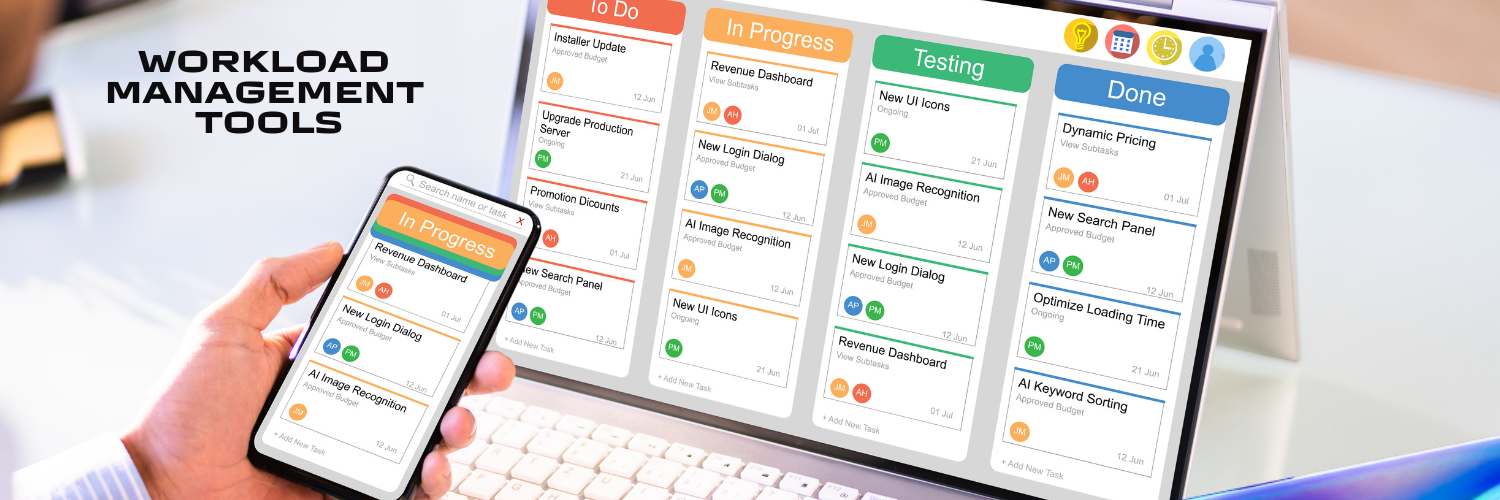The Best 8 Balanced Professional Techniques to Manage Workload
Managing workload effectively is crucial for maintaining productivity and avoiding burnout. Explore the top eight professional techniques for achieving a balanced approach to workload management.

Balanced professional techniques refer to a set of best practices that:
- promote a healthy work life balance
- help achieve optimal performance in a professional setting.

Why they are important: They make the workload management process (planning, organizing, and distributing work among team members) easier.
The goal of balanced professional techniques is to create a sustainable and productive work environment that supports the overall wellbeing and success of employees without compromising on performance or professionalism. 🧘♂️💻
The balanced professional techniques in the list below explain time management, productivity, and workload optimization.

Collectively, they argue that prioritizing productivity is more crucial than it has ever been, transforming the way you manage your time and elevating backlogs from extensive to-do lists to powerful tools for team collaboration.
Understanding every aspect of workload management may not be realistic, but these resources simplify the journey, making it far more approachable.
Master Time Blocking

This technique involves dividing the day into blocks of time, each dedicated to accomplishing a specific task or group of tasks.
Instead of working with a traditional to-do list, this method encourages professionals to schedule everything, including:
- work tasks
- meetings
- breaks.
Time blocking helps:
- prevent task overflow
- ensure that sufficient time is allocated to each task
- consider task dependencies
- signal availability.
In turn, it increases focus and productivity, as it limits the likelihood of multitasking and its negative impact on meeting deadlines.
In combination with time tracking, time blocking:
- provides a comprehensive picture of time utilization
- gives insights for future planning and workload distribution.

Automate Work Processes

Remember that automation should augment human capabilities, not replace them. Focus on automating tasks that are:
- repetitive
- time-consuming
- prone to errors
- use the freed-up time to focus on higher-value activities like strategy, creativity, and relationship-building.
Identify repetitive tasks
Look for tasks that are performed repeatedly and can be automated using software or tools. Examples include data entry, scheduling, and email marketing.
Implement business process automation (BPA)
BPA refers to the use of technology to automate repeatable business processes. It can help streamline processes, reduce errors, and increase productivity. Examples of BPA include automating customer service interactions, generating reports, and processing transactions.
Use AI tools for productivity
AI and ML can be used to automate complex tasks such as data analysis, pattern recognition, and predictive modeling. For example, you can use AI-powered chatbots to handle customer inquiries or use ML algorithms to automatically categorize and prioritize tasks.

Integrate systems
Integrations ease the automation of data transfer and minimize the manual input. For instance, you can integrate your CRM system with a marketing automation tool of your choice to automatically sync customer data and lead scores.
Automate reporting
Automating report generation can save time and reduce errors. You can use tools like Tableau, Power BI, or Google Data Studio to create interactive dashboards and reports that update automatically.
Outsource non-core functions
Consider outsourcing non-core functions such as bookkeeping, payroll, or social media management to free up internal resources for more strategic tasks.
Revolutionize Your Weekly Planning

If you struggle to find time for your long-term goals amidst the burdens of handling the workload, then it is time to take a new approach to weekly planning.
Roger Seip, author of "Train Your Brain for Success," has developed a game-changing technique he called 2-Hour Solution.
This innovative method is a powerful tool for workload management: all it takes is allocating two hours each week to meticulously plan the next seven days. But here's the twist – you need to segment your time into four distinct categories to gain laser-sharp focus on your goals and a clear path forward.
- Green Time (The Work That Gets You Paid)
This is the time dedicated to the activities that generate income and drive your professional growth. Focus on the tasks that directly impact your career advancement, business success, or financial stability. Make sure to prioritize your most important responsibilities during this time, as they will lay the foundation for your long-term prosperity.
- Red Time (The Time That Supports Your Green Time)
Red time encompasses all the behind-the-scenes tasks that facilitate your green time. Think of administrative duties, research, learning new skills, or networking. These activities might not bring in immediate revenue, but they're crucial for supporting and amplifying your primary income streams. Allocate sufficient red time to ensure your green time runs smoothly and efficiently.
- Flex Time (Unblocked Time to Address the Unexpected)
Life is unpredictable, and unexpected events can derail even the best-laid plans. Flex time provides a buffer zone for dealing with surprises, last-minute obligations, or sudden emergencies. By setting aside this time, you'll be better equipped to handle unexpected situations without sacrificing your green or red time.
- Recreation Time (Hobbies, Relaxing, Exercise, Etc.)
A well-rounded life requires balance, and recreation time is essential for maintaining your physical and mental health. From hobbies and interests to relaxation and self-care, use this time to nurture your mind, body, and spirit. Adequate recreation time will boost your creativity, productivity, and overall well-being.
Apply Workload Management Tools

Workload management tools offer dashboards, reports, and multiple project management options assisting teams in managing workload.
Tools like JIRA, Asana, Trello, Teamwork, and Zoho Projects in integration with time tracking can help teams of any size:
- organize backlogs
- monitor task in progress
- manage project deadline
- distribute work evenly among the team.
Also, they help evaluate the full workload across your team, have a clear understanding of all the work happening within your agency, and identify areas of workload imbalance.
Use Work Plan Templates

Work plan templates are a strategic tool in workload management with the ability to streamline the process of:
- delegating tasks
- setting deadlines
- tracking progress.
They are effective because they offer a range of features that help managers and teams organize and communicate effectively, bringing clarity to projects and tasks. In particular, they can benefit workload management in various ways.
- Clear Task Allocation: Templates can outline specific tasks assigned to individuals or groups. This removes ambiguity about responsibilities and helps prevent overlap in duties.
- Resource Allocation: Templates can assist in the efficient distribution of resources, ensuring that team members have what they need to complete their tasks without unnecessary downtime.
- Communication: By providing a shared document that outlines the plan, everyone on the team can stay informed about the project's status and their colleagues' work, fostering better collaboration.
The most versatile templates that can be adapted to various scenarios include:
- Gantt Chart Template (it visualizes the timeline of a project, including when tasks should start and finish and how they overlap)
- Kanban Board Template (it ideally suits agile teams that prioritize flexibility in task management)
- Task List Template (being simple and straightforward, this template brings instant clarity to task pools, including due dates and responsible persons).
- Project Plan Template (it is a comprehensive solution for listing all the objectives, key performance indicators (KPIs), detailed tasks, timelines, and roles).
- Resource Management Template (it is an assistant in tracking the allocation of resources to projects, ensuring that there's no over- or under-utilization of team capacity).
How to select work plan templates? Selecting the right template often involves considering the following:
- the project's complexity
- the team's working style
- the level of detail required for effective management.

Benefit from the Power of Ambient Sounds

By creating a consistent and predictable auditory environment, individuals can stay focused on their work and better manage their workload.
Ambient sounds can be the best solution as they act as a buffer, masking external distractions, and have the power to envelop us in a cocoon of focus on the task at hand.
They also help to quell intrusive thoughts, provide a comforting background hum that keeps us engaged, and remove an oppressive feeling of complete silence.
Here are some tips for using ambient sounds to benefit workload management:
- Ambient sounds, such as white noise or nature sounds, can help create a calm and distraction-free work environment. They can drown out background noise and increase concentration.
- Certain ambient sounds, like instrumental music or sounds of flowing water, can create a pleasant atmosphere that promotes creativity, motivation, and a sense of flow, ultimately helping individuals increase productivity.
- Workload management often involves handling multiple tasks and deadlines, which can lead to stress and overwhelm. Ambient sounds, such as gentle rain or soothing melodies, can have a relaxing effect on the mind and body by reducing stress levels.
- Some ambient sounds, like office background noise or coffee shop sounds, can mimic the familiar working environment and help establish a work-like atmosphere, which aids in managing workload.

Experiment with different types of ambient sounds to find what works best for you and use them in conjunction with other workload management strategies, such as time tracking and task prioritization.
Use the Rule of Five for Workload Mastery

In the quest for equilibrium within the throes of professional demands, establishing a set of guiding principles can help take your team's collaboration to new heights.
We call it the 'Rule of Five'. It is a powerful framework that combines:
- assertiveness
- empathy
- active listening
- adaptability
- pursuit of truth.
With these five tenets at its core, your team will be better equipped to manage workload effectively, navigate conflicts, and make informed decisions that drive success.
Assertiveness promotes precision and purpose and helps us master rather than avoid the prevailing winds that dictate our corporate climate.
The act of Empathetic Reception follows, where the focus is on absorbing communicated messages in their purest unbiased form. This practice involves a deep connection, promotes transparent communication, and contributes to creating a holistic workspace.
Active listening enhances problem-solving and decision-making processes. To use it effectively, it is important to concentrate on the speaker, understand their message, respond appropriately, and remember the information, all without prematurely judging or interrupting.
Being adaptable means being flexible and open to new ideas and approaches, especially when faced with unexpected challenges.
The final note is the pursuit of truth. Such a standard is the cornerstone of trust and integrity that ensures quality as the top goal in our professional endeavors.
These principles form the backbone of a harmonious approach to managing workloads, one that advocates for a balanced, authentic, and ethically sound professional life.
Review & Adjust

Finding the right balance in workload management is an ongoing process that requires continuous improvement.
Continuously monitor your automated processes and optimize them as needed. Look for areas where processes can be improved, bottlenecks removed, and efficiency increased.
Thus, it is important to regularly review your workload management strategies by reflecting on what is working well and what can be improved – this is the only guaranteed way to optimize your capacity planning at best.
However, to truly advance, it's essential to uphold rigorous standards while recognizing that perfection is unattainable. This approach to adjustment allows for growth without the unrealistic expectation of flawlessness.
With these strategies, you'll be able to strike the right balance between different demands and responsibilities, leading to greater efficiency and effectiveness in your workload management.
Best 10 Balanced Professional Techniques to Manage Workload with Ease
There are many effective techniques to manage workload, but here are ten of the best practices to keep in mind:
- Master time blocking
- Automate work processes
- Revolutionize your weekly planning
- Apply workload management tools
- Use work plan templates
- Benefit from the power of ambient sounds
- Use the rule of five for workload mastery
- Review and adjust.
These techniques can help create a balanced and productive work environment where team members feel empowered to manage their workload effectively. 🙌🏻📊
.


